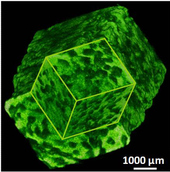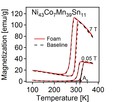Highlight
New Magnetically Morphing Scaffold Material For Biomedical Applications
Achievement/Results
Tissue engineering is a major emerging field of biomedical research, with the potential to allow organs to be repaired or even replaced as needed in the future. A team at Texas A&M University has developed a new material which may allow the development of customizable frameworks for such applications. The new material is a meta-magnetic shape memory alloy (MMSMA) foam, developed as a potential morphing tissue scaffold for biomedical applications. Shape Memory Alloys (SMAs) are already utilized for medical stents, which undergo a one-time reconfiguration after insertion into blocked arteries. Meta-magnetic shape memory alloys (MMSMAs) are new materials allowing potentially repeatable reconfiguration within the body. A morphing tissue scaffold based on such materials would provide support for cellular growth, much like a structural scaffold provides support for a building, and could “massage” bodily tissue which has been shown to stimulate pancreatic and bone cell growth. A MMSMA is a special class of material that can link magnetic, mechanical and thermal energy domains which means that the material can change one form of energy into another. For example, it may change shape if thermal and/or magnetic energy is supplied or change temperature if magnetic and/or mechanical deformation energy is supplied. The magnetic and thermal coupling also allows for another potential application for this material, magnetic refrigeration. Magnetic-based refrigerant materials have the potential to replace chloro-fluorocarbons, and the foam configuration developed here could be an ideal geometry for this application.
Previous research has shown that the introduction of 300μm-500μm pores allows bodily tissues to bond to scaffolds. An achievement by a group at Texas A&M University was to create NiCoMnSn MMSMA foams with 300μm-500μm selected pore size distribution. The foams were created by blending ammonium bicarbonate and pre-alloyed powders, pressing them in a die and heat treating the resulting compact. The ammonium bicarbonate is burned out during a slow heating process, leaving behind pores of a selected size, while the alloy particles are sintered, or consolidated, in a final hold at a temperature below the melting point. The green micro CT image shows the resulting NiCoMnSn alloy foam with interconnected pores.
The first ever magneto-thermo and thermo-mechanical tests on a MMSMA foam were then conducted to characterize the foam’s magneto-thermo-mechanical coupling characteristics. The magneto-thermo response shown in the Stress vs. Strain graph displays the foam being deformed then recovering its shape upon heating. This is known as the shape memory effect and is an indication of the shape memory performance of a MMSMA. The magneto-thermo response in the Magnetization vs. Temperature graph exhibits how the material’s magnetic character changes with temperature. Selecting the correct processing parameters produced a foam with a response identical to a baseline material that shows the best performance for the bulk selected material.
Address Goals
This work was performed by James Monroe, Ibrahim Karaman, and collaborators at Texas A&M University. James Monroe is a graduate student in the “New Mathematical Tools for Next Generation Materials” interdisciplinary team at Texas A&M with support from the NSF-IGERT (Integrative Graduate Education and Research Traineeship) program. His graduate work in this program has included strongly interdisciplinary coursework as well as research with faculty covering several departments. Another important part of this project is a collaboration with a group at Tohoku University, with partial support from the NSF Materials World Network program. The work was performed with Ibrahim Karaman, in Mechanical Engineering as well as chair of Materials Science at Texas A&M, and is part of a larger effort including several faculty and five IGERT trainees at Texas A&M developing new Shape-Memory materials through experimental and computational modeling work. The interdisciplinary training and international collaborative efforts behind this work were an essential part of the research, and in turn the experience of this collaborative team has contributed to the further development of the interdisciplinary Materials Science curriculum at Texas A&M. Thus this program is helping to build a world-class, broadly inclusive science and engineering workforce, one of the strategic goals of the NSF. Moreover, this work on MMSMA foams is the first of its kind in worldwide, and its potential applications address issues of current importance for medicine and other fields, and thus is an excellent example of knowledge discovery with significance for the nation, also a strategic goal of the NSF.








